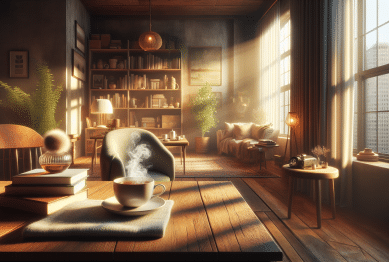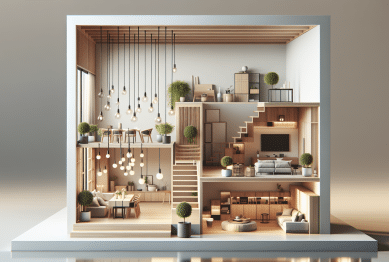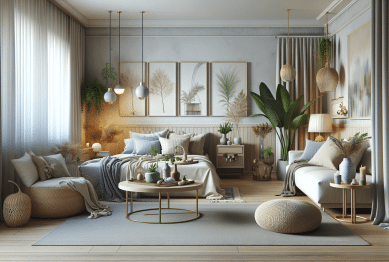Discover practical, real-life strategies to embrace minimalist living and create a clutter-free lifestyle. Uncover how small changes in daily habits can unlock simplicity, freedom, and personal happiness while making room for more meaningful moments.
What Minimalism Really Means for Everyday Life
Minimalism is so much more than just a neatly organized closet or a home without clutter. At its core, minimalist living encourages people to focus on what truly matters and let go of distractions. The minimalist lifestyle brings clarity, allowing for intentional choices around possessions, time, and relationships. Many find that adopting minimalism makes each day feel lighter, giving space for self-improvement, creativity, and rest. By paying attention to essentials and leaving behind excess, minimalist living can help reduce stress and create a supportive home environment, transforming how daily life feels from the moment you wake up.
People often assume that living more simply means extreme sacrifices, but minimalism is about prioritizing quality over quantity. It’s about asking which things, habits, or relationships add value and which create unnecessary complexity. Choosing only items that serve a real need can help eliminate the constant feeling of being overwhelmed by ‘too much.’ For many, this shift leads to a healthier mindset. Minimalist living encourages discipline without deprivation, and studies show that minimizing material possessions may even support improved mental health and emotional well-being (https://www.nih.gov/news-events/nih-research-matters/decluttering-mental-health).
This philosophy has gained traction not only in design and home organization, but also in fashion, entertainment, eating habits, and digital life. People who practice minimalism often notice they’re more present in daily routines and relationships. Minimalist approaches allow anyone to streamline decision-making, offering peace that comes from living with intention rather than distraction. Whether you live alone or in a bustling household, exploring minimalist ideas can reveal a surprising sense of freedom. Try noticing how fewer choices or distractions can lead to more time and mental space for the experiences you value most.
The Surprising Benefits of Minimalist Living
Minimalism isn’t just about less stuff—it’s the path to more time, energy, and purpose. One of the most powerful benefits is the way it helps simplify routines and reduce decision fatigue. Imagine waking up and knowing exactly what you’ll wear because your wardrobe only contains clothes you love and use. Everyday tasks take less energy and time, which can boost productivity and free up precious moments for hobbies, rest, or relationships. Even simple changes, like reducing digital clutter or limiting unnecessary commitments, bring clarity to your schedule and mind.
There is also a financial aspect. Minimalist living can assist people in discovering value in what they already own instead of seeking out new purchases. The shift from buying more to buying less-with-purpose saves money. With a focus on needs rather than wants, many individuals experience stronger financial health over time. This sense of security has ripple effects, supporting better mental wellness and life satisfaction. Studies suggest that those who simplify at home often feel less anxious, enjoy improved sleep, and perceive their space as safer and more comforting (https://www.apa.org/monitor/2019/07-08/cover-decluttering).
Minimalist living also aligns well with eco-friendly values. By consuming less and choosing durable, multipurpose items, individuals significantly reduce their environmental impact. Minimalism encourages upcycling, donating, or selling unneeded items, fostering a supportive community built on sharing rather than accumulations. Even minimalist entertainment—such as spending more time outdoors, reading, or enjoying music—can promote deeper fulfillment, cutting back on screen time and digital overload. Simplicity brings profound benefits: energy, focus, and the ability to appreciate the small joys each day offers.
Decluttering Tips That Work for Any Space
Getting started with decluttering can seem daunting, but it’s easier with a step-by-step approach. Begin by tackling manageable areas—maybe a single drawer or shelf. Observe what you use daily and set aside what’s purely decorative or rarely needed. The “one in, one out” method is popular: add something new only when you let go of something else. This habit keeps accumulation at bay and forces prioritization. Another powerful tactic is to schedule regular decluttering sessions, which encourages lasting habits rather than a single, overwhelming event.
Many find it helpful to sort belongings into categories such as keep, donate, recycle, or sell. Labeling boxes can simplify this process. For emotional or sentimental items, designate a specific space or box rather than scattering them throughout the home. Minimalist living doesn’t require parting with everything; it simply means making space for the meaningful. Donate gently used household goods or clothing to local charities, giving your old favorites a second life with someone who needs them. This can bring satisfaction and a sense of connection to the broader community.
Decluttering digital spaces is just as important as physical ones. Clear out old emails, organize digital files, and unsubscribe from newsletters that don’t offer meaningful value. Consider adopting a minimalist approach to your smartphone, keeping only essential apps and eliminating constant notifications. These simple actions can have an immediate impact on mental clarity and focus. As you ease into decluttering, notice how a lighter environment encourages a lighter mind—and how maintaining simplicity requires only a little regular attention.
Mindful Consumption and Simple Habits
Minimalist living embraces mindful consumption—consciously choosing what comes into your life. One key strategy is to pause before making new purchases, asking if the item fulfills a defined purpose or brings genuine joy. Many people find that waiting a week before buying something often leads to a change of heart, reducing impulse shopping. Keeping a running wish list, rather than purchasing immediately, makes it easier to distinguish between passing wants and lasting needs. This approach aligns with sustainability and intentional living values.
Cultivating simple habits creates space for more of what matters. Consider adopting daily or weekly routines for tidying up and clearing workspaces, which supports mental clarity and stress relief. Meal planning is another minimalist habit, reducing food waste and decision fatigue around eating. Minimalism can even extend to leisure activities: instead of filling time with errands or passive entertainment, try exploring creative passions, meaningful conversations, or nature walks. These activities remind people to value experiences over things. Research shows that minimalists tend to feel less rushed and more satisfied with their use of time (https://www.ncbi.nlm.nih.gov/pmc/articles/PMC6367884/).
Reducing social media and digital distractions fits hand-in-glove with a minimalist mindset. Set time limits on apps or try device-free periods to see how this alters your focus and mood. The rewards can be surprising. A less cluttered digital life leads to richer experiences offline, deeper relationships, and even improved confidence to say “no.” Simplicity starts with small shifts, turning ordinary moments into time for self-reflection, gratitude, and relaxation. As these habits become part of daily life, they nurture long-term wellbeing.
Minimalist Decor: Transforming Spaces with Less
Minimalist interior design isn’t just about white walls and empty rooms—it’s about intentionality and calm. Select versatile, well-made furniture pieces that serve more than one purpose. Use a limited color palette with a few accents for warmth, incorporating textures like wood or linen. Natural light and open spaces are emphasized for their soothing, invigorating qualities. Artwork and decorations are carefully chosen, acting as focal points rather than clutter. Living with less in your physical space doesn’t mean sacrificing personal style; it means showcasing only what truly uplifts and inspires.
Organization is key to minimalist living. Every item should have a defined “home,” making tidying up quick and stress-free. Storage solutions such as baskets, wall-mounted shelves, or under-bed containers can help keep essentials accessible but out of sight. Plants or simple decorative objects bring life to a space without overwhelming it. This approach creates an environment that fosters peace, making it easier to relax or focus, whether working from home or enjoying downtime (https://www.houzz.com/magazine/how-to-create-a-minimalist-home-stsetivw-vs~132997109).
When deciding what stays and what goes, listen to how each item makes you feel. Do you smile when you see it? If not, it might be time to let go. Understanding the emotional connection to belongings is an important part of creating a space that energizes and calms in equal measure. Many discover that minimalist decor encourages a sense of gratitude, as each remaining item is chosen for its purpose, beauty, or joyful association. The result: a home that feels serene, functional, and uniquely yours.
Minimalism Beyond the Home
The principles of minimalism can transform all aspects of life, not just the home. Streamlining schedules by reducing non-essential commitments lets you reclaim time and energy. Saying “yes” with intention allows for deeper connections and more memorable experiences. Minimalism can apply to work, where clearing your desktop, choosing essential projects, and batching tasks frees up mental bandwidth and increases satisfaction. Consider simplifying routines around fitness or self-care by focusing on activities that bring enjoyment and lasting benefits.
Minimalists often find themselves building stronger, more purposeful relationships. By cutting back on obligatory gatherings and investing time in those who matter, personal connections become richer. Social calendars turn from crowded to curated. Online minimalism is also powerful—declutter your social media feed, unfollow accounts that distract or stress you, and use technology to support, not dominate, your day. This simple edit can enhance feelings of positivity and boost self-confidence (https://www.psychologytoday.com/us/blog/smart-blogger/201611/the-psychological-benefits-minimalism).
Minimalist travel is another growing trend. Packing lightly, choosing experiences over souvenirs, and focusing on local culture instead of tourist traps can create more memorable, less stressful adventures. Minimalism encourages mindful exploration—whether close to home or far away. As the mindset grows, its influence can be seen in how people eat, learn, work, and socialize. Minimalism is not about lack, but about consciously making space for what matters most—in every part of life.
References
1. National Institutes of Health. (2020). Decluttering for Mental Health. Retrieved from https://www.nih.gov/news-events/nih-research-matters/decluttering-mental-health
2. American Psychological Association. (2019). The art and science of decluttering. Retrieved from https://www.apa.org/monitor/2019/07-08/cover-decluttering
3. National Center for Biotechnology Information. (2019). Minimalism, Mindfulness, and Well-Being. Retrieved from https://www.ncbi.nlm.nih.gov/pmc/articles/PMC6367884/
4. Houzz Editorial Staff. (2022). How to Create a Minimalist Home. Retrieved from https://www.houzz.com/magazine/how-to-create-a-minimalist-home-stsetivw-vs~132997109
5. Psychology Today. (2016). The Psychological Benefits of Minimalism. Retrieved from https://www.psychologytoday.com/us/blog/smart-blogger/201611/the-psychological-benefits-minimalism
6. The Minimalists. (2022). 16 Rules for Living With Less. Retrieved from https://www.theminimalists.com/rules/









